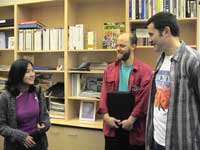UCSD Division Tours High Tech High
|
1.29.03 - On Friday, January 24, UCSD division staff representing the technical, communications, and development domains visited High Tech High to explore ways to integrate Calit²'s research and educational initiatives with HTH's already impressive, if very short, history in engaging motivated students with technology.
Known formally as the Gary and Jerri-Ann Jacobs High Tech High School, HTH serves as a public charter high school in San Diego specializing in math, science, and engineering. Launched in September 2000 by a coalition of industry and educators, HTH occupies a portion of the former Naval Training Center in San Diego. A small, diverse learning community, HTH is founded on three principles: personalization, adult-world connection, and a common intellectual mission.
Innovative features of the school include performance-based assessment, daily shared planning time for staff, state-of-the-art technical facilities for project-based learning, internships required for all graduating students, and close links to the high-tech workplace.
The school has an impressive list of industrial sponsors that provide funding and donate significant amounts of individuals' time to mentor the students. The program has already been so successful that it is planning to open a complementary middle school this coming fall inviting grades 6-8 to join its exciting experiment.
Surprisingly for a school focused on technology, the school is decorated throughout with examples of students' fine artwork and other expressions of their creativity, some of which will be selected for auctioning in a future art gala (date in the process of being determined). The school's space, based in a former Navy warehouse, is designed as very open and welcoming. Obvious, at first glance, are lots of trays overhead holding CAT-5 cabling.
More than 200 computers serve the student body of 400, an encouraging ratio by comparison with most schools. About a third have been donated from various sources including La Jolla Biotech companies, individuals, grants, and even the Miramar Military Brig. These donations are critical to the school achieving - and maintaining - its stated goal of a 2-to-1 student-to-computer ratio.
But what is most impressive is the school's singular mood: Smiling, energetic students eagerly concentrating in small groups and individually. And there's an almost peer relationship between the unusually committed staff and the students.
As a unique indication of the solidarity and vested interest the school promotes, students are asked to work together in a co-op to provide custodial services to preserve as much funding as possible to provide the best computer equipment and networking. They also oversee the discipline of their own by contributing student members to a committee that works with high school administrative staff to address the few student behavior problems that occur. Perhaps most significant, especially by comparison with most modern-day high schools, is that, each spring, the students are asked formally to renew their commitment to return in the fall. The school is very clear: If you indicate by your behavior that you don't value the program the school will find others that do.
In discussions with Rebecca Haddock, HTH director of outreach, Calit² staff discussed various types of engagement:
- Providing periodic speakers for the schools "power lunches." As evidence of the school's magical influence, their first speaker a couple of years ago subsequently came to work as head of their Information Technology department - he was Peter Estacio from the San Diego Supercomputer Center!
- Working with teachers to develop curricula on specific topics.
- Mentoring students by Calit² faculty and staff in a broad range of topics ranging from wireless implementations to more traditional oral and written communication - all important life skills for today's high school students.
- Supporting internship programs.
- Including HTH in outreach components of UCSD NSF research grants (some of which have already been submitted).
HTH is planning an art gala, led by the San Diego Telecom Council, to raise funds to support a proposed wireless lab for the school. Calit² technical staff, led by David Hutches, is providing advice and equipment to implement a temporary wireless capability for the event to demonstrate, for gala attendees, the power of wireless. Plans call for HTH students, during the event, to help attendees determine which art to buy by acquainting them with information on the artists via Web sites shown on wirelessly connected tablet PCs. Emblematic of the success of the school's program, planning of this event is being overseen, as her internship project, by Nicole Le, an HTH junior!
For more information on HTH, see www.hightechhigh.org.
Related Links

